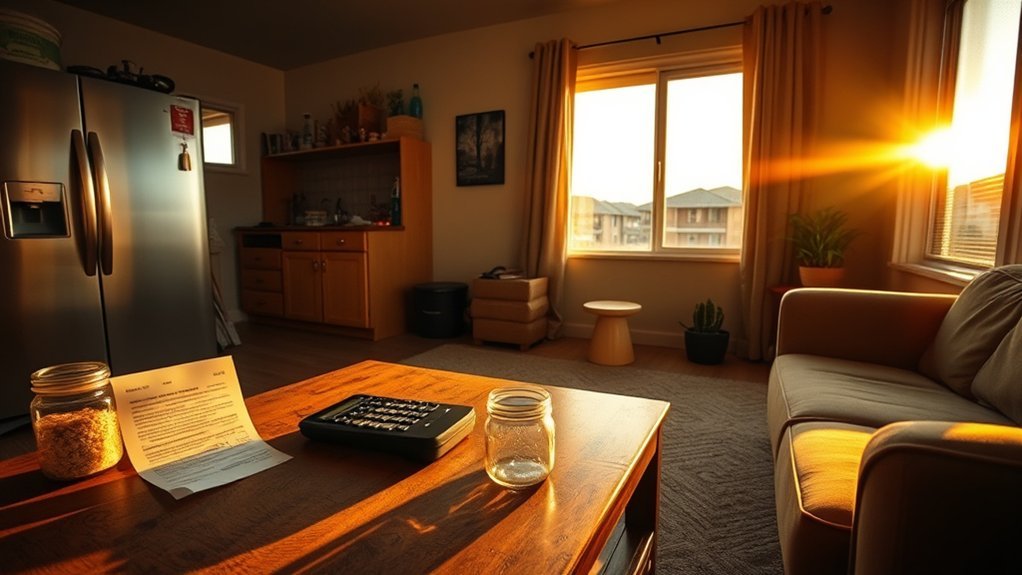You’ll typically need about $4,200 a month (roughly $50,000 a year) to comfortably afford a one‑bedroom in Garland, where average rents run about $1,253/month. Studios average ~$1,101, two‑beds ~$1,561 and three‑beds ~$1,941+. Add utilities ($150–$250), groceries ($250–$350) and transport ($60–$200) and essentials push your budget higher. Neighborhoods vary by hundreds monthly — keep going to see specific areas, income targets and savings tactics.
What Is the Typical Monthly Housing Cost in Garland?
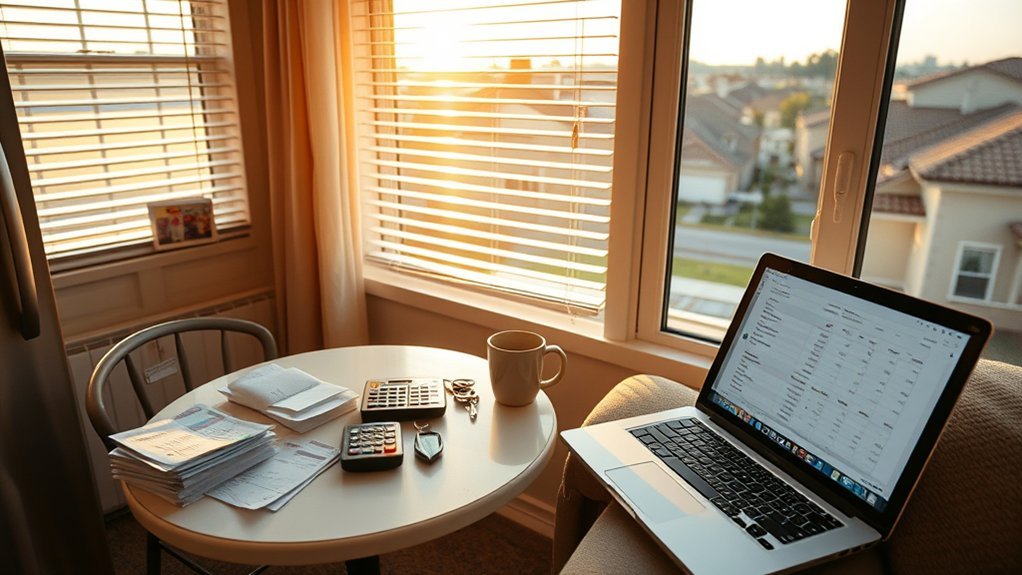
Typically, you’ll find monthly rents in Garland running roughly $1,253–$1,435 on average depending on the source and unit mix. You should expect a one-bedroom apartment to average about $1,253, with studios near $1,101 and larger units rising to $1,561–$1,941+.
That average rent puts Garland roughly 14–23% below national rents and gives a housing index near 84 versus the U.S. baseline, so your Cost of Living for housing is relatively lower. Using the 30% affordability rule, you’d need roughly $4,176 in monthly income (about $50,112/year) to avoid overspending on that typical rent.
Neighborhoods in Garland do vary: Westcreek Estates, Sutton Place, and Chandler Heights sit below the city average, while Shoal Creek and Villages of Valley Creek push well above it, so you’ll balance price with location when planning your monthly housing budget.
Average Rent by Unit Type and Neighborhood
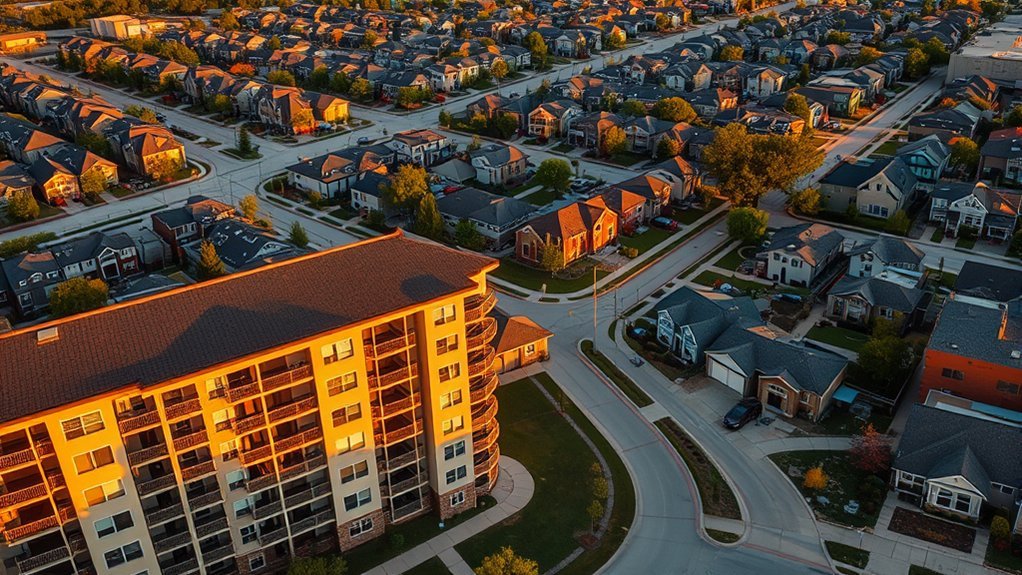
Dig into Garland’s rents and you’ll see clear patterns by unit type and neighborhood: the citywide average sits around $1,253/month (October 2025), with studios at about $1,101, one‑beds $1,253, two‑beds $1,561, and three‑beds $1,941+, while the average apartment measures roughly 882 sq ft.
You’ll find smaller units in Sutton Place (~693 sq ft) and Downtown Garland (~744 sq ft), which helps keep their rents competitive.
Sutton Place ($1,137/mo) and Westcreek Estates ($1,170/mo) are the standout affordable neighborhoods; Castle Point ($1,964/mo) and Shoal Creek ($1,629/mo) sit at the high end.
Citywide availability concentrates in Downtown, Castle Point and Sutton Place, with about 5,010 apartments reported available.
Overall average rent in Garland (~$1,253–$1,435 depending on data) runs roughly 23% below the national average and has eased about 1.6% year‑over‑year (≈ $20/month). Additionally, understanding construction costs is essential when planning for future housing investments.
Use these figures to target neighborhoods and unit types that match your budget and space needs when you search for rent for an apartment.
How Much Income You Need to Afford Rent in Garland

To comfortably afford a typical one‑bed in Garland at the commonly used 30% rent‑to‑income rule, you’d need roughly $4,176 per month — about $50,112 per year — which is below the city’s median household income of roughly $60,000.
Using that 30% benchmark, rent in Garland averaging $1,253/month implies you need to plan for about $50k annual income.
Because reported averages vary ($1,253–$1,435/month), you should target gross annual income between roughly $50,000 and $57,400 to live comfortably without stretching your budget.
Neighborhoods shift the math: lower‑cost Sutton Place at ~$1,137/month needs about $45,480/year, while higher‑end Castle Point at ~$1,964/month requires about $78,560/year.
Rents have edged down roughly 1.6% year‑over‑year (≈$20/month), so income targets tied to current averages may fall slightly if that trend continues.
Additionally, repair costs for school computers can impact family budgets, especially if children rely on technology for education.
Use these figures to set realistic per month and annual income goals before leasing.
Utilities, Groceries, Transportation and Other Essentials

You’ll want to budget utilities at about $150–$250 a month, with summer cooling potentially adding $50–$150 more and average electric bills around $154.90 for 1,000 kWh (about 15.49¢/kWh).
Groceries run roughly 1% below the U.S. average (bread $3.90, milk $4.64, eggs $3.52), while transportation tends to be ~9% cheaper—expect driving costs near $200/month or public transit about $60/month, and storage units around $96. Additionally, regular inspections of your air conditioning system can help prevent costly repairs down the line.
Monthly Utility Breakdown
While utility bills in Garland generally run $150–$250 per month, expect summer cooling to add another $50–$150 when temperatures spike, pushing some households well above the base range. You’ll budget utilities and monitor your energy bill; average monthly bills near $154.90 for ~1,000 kWh reflect electricity at about 15.49¢/kWh. Track seasonal cooling to avoid surprises and consider efficiency measures to trim utility costs.
| Category | Typical Monthly | Notes |
|---|---|---|
| Electricity | $155 (avg) | ~1,000 kWh example |
| Total utilities | $150–$250 | Base range |
| Summer peak | +$50–$150 | Seasonal cooling impact |
Include other essentials (phone, healthcare, storage) separately when totaling monthly living costs.
Grocery & Transport Costs
With utilities and cooling costs accounted for, shift focus to groceries, transportation, and other monthly essentials that round out your budget.
Groceries in Garland run about 1% below the U.S. average: expect bread $3.90, milk $4.64, eggs $3.52, and a single adult spending $250–$350/month depending on diet and shopping choices. Pair that with monthly utilities roughly $150–$250 (electricity ~ $154.90/month for 1,000 kWh) and phone costs nearing $225/month when planning totals.
Transportation expenses are also favorable: public transit about $60/month, while driving (gas, maintenance, insurance) averages ~$200/month given a typical Garage commute of ~28.4 minutes. Factor these into your Cost of housing calculations for an accurate monthly essentials estimate.
Where Garland’s Most Affordable and Most Expensive Neighborhoods Stand
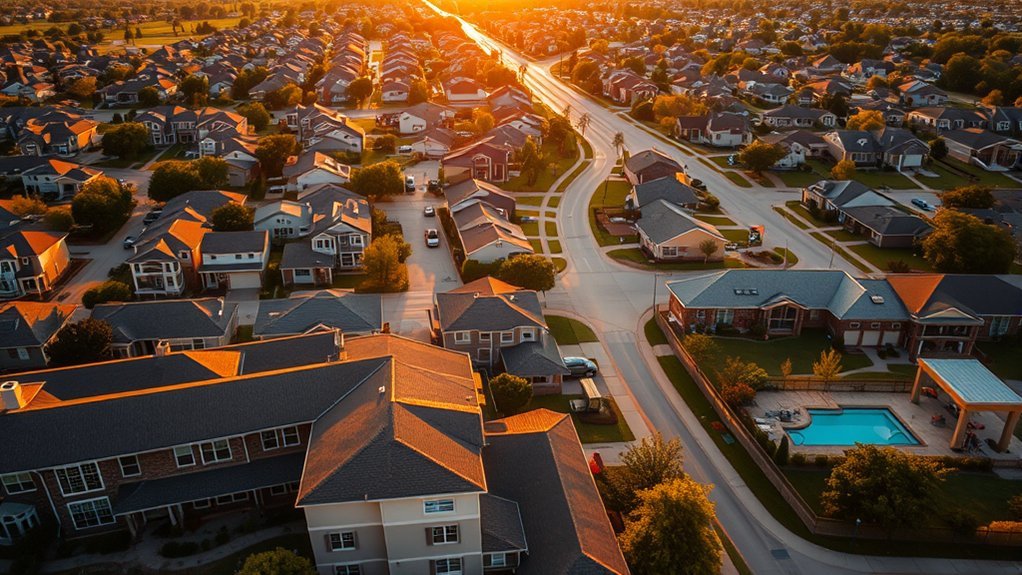
Because Garland’s rental market swings sharply by neighborhood, you can shave hundreds of dollars off your monthly housing cost simply by choosing where you live.
Look at the numbers: Sutton Place sits among Garland’s affordable neighborhoods with average rent near $1,137/month for roughly 693 sq ft, while Castle Point represents one of the expensive neighborhoods at about $1,964/month for ~787 sq ft.
Downtown Garland is popular and has relatively high availability, averaging $1,379/month for ≈744 sq ft, making it a middle option with good stock.
Citywide availability is concentrated in Sutton Place, Downtown, and Castle Point, part of an overall pool of roughly 5,010 available apartments.
Neighborhood-level variation continues from Westcreek Estates (~$1,170/mo) up to Villages of Valley Creek (~$2,067/mo).
Use these average rent benchmarks to compare unit size, location, and inventory so you can weigh cost versus convenience when choosing where to live in Garland. Additionally, understanding initial startup costs associated with opening a group home can provide valuable insights into overall living expenses in the area.
Tips to Lower Your Monthly Living Costs in Garland
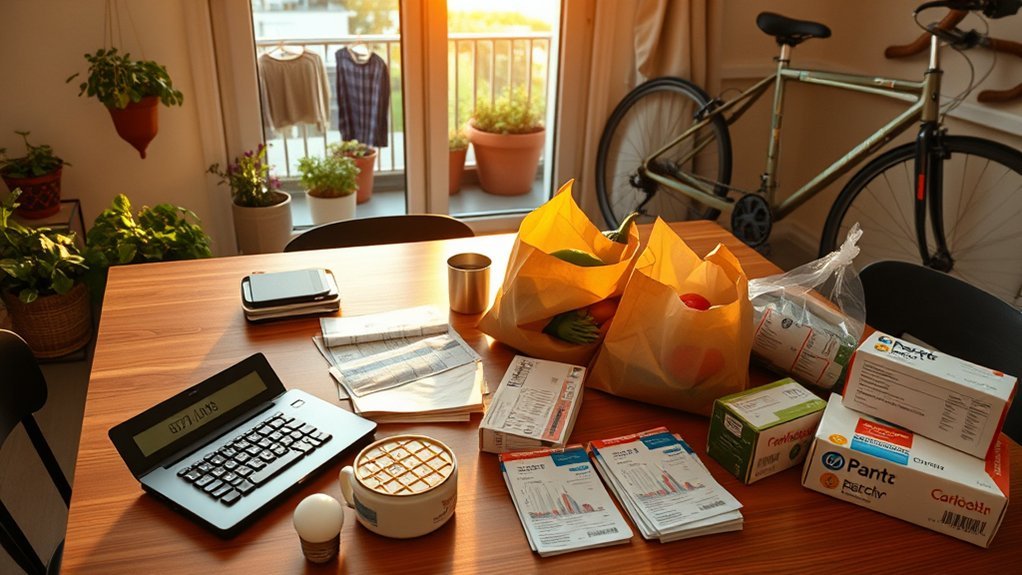
Having compared neighborhood rent benchmarks, you can cut your monthly cost by applying targeted strategies across housing, utilities, groceries and fees. Aim to keep rent at or below 30% of income: with Garland average rent near $1,253–$1,435, you’d need about $4,176–$4,783 monthly.
To save on housing, target more affordable areas—Sutton Place (~$1,137), Westcreek Estates (~$1,170) or Chandler Heights (~$1,197)—rather than pricier Shoal Creek (~$1,629). If you’re shopping for an apartment in Garland, compare listings with total monthly fees to make certain overall Cost stays manageable.
Cut utility costs during hot months with programmable thermostats, LED bulbs and off‑peak appliance use to offset $50–$150 cooling spikes.
Lower grocery bills by using Aldi, Walmart and farmers markets, and use libraries for free entertainment.
Reduce extra fees by comparing local 10×10 storage averages (~$95.91) and avoiding units with high HOA or hidden charges. These steps help you live comfortably while keeping housing expenses lower than the national pressures suggest. Additionally, understanding the operational expenses of your living situation can help you budget more effectively.
How Garland Compares to Nearby Cities and the National Average
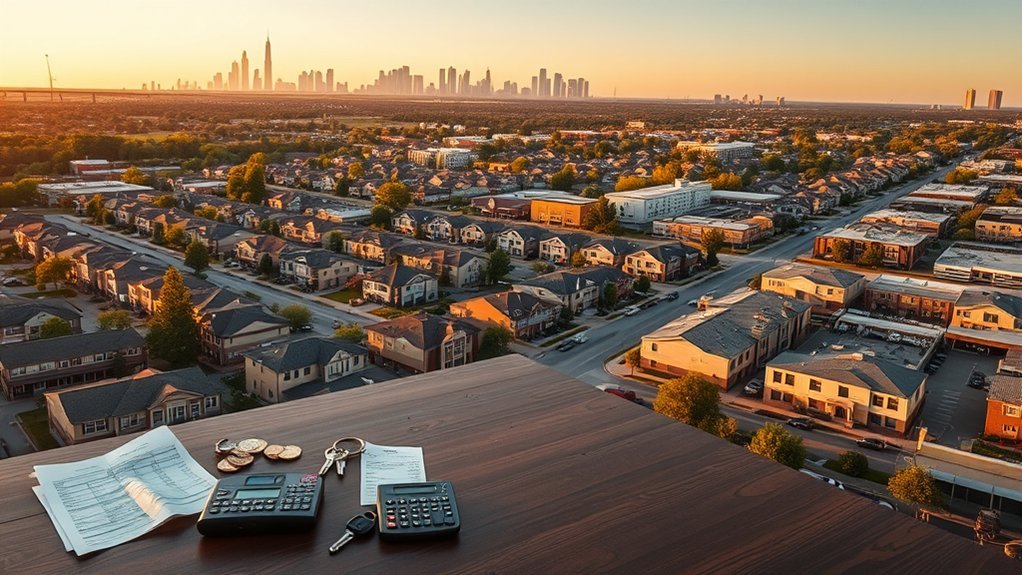
Compared to the national picture and nearby DFW suburbs, Garland stands out as a more affordable option: average rents run about $1,253 for a one‑bed and $1,435 overall—roughly 23% below the U.S. mean of $1,629—while the local housing index (~84.0) and median home price (~$274,900) sit below many neighboring cities.
You’ll find housing affordability is the main driver: lower rents and home prices mean you need about $4,176/month ($50,112/year) to meet the 30% rent rule, less than many nearby suburbs.
For total monthly costs, factor in higher utilities cost—about 15% above the national average—which erodes some savings.
Transportation and groceries are modestly cheaper (transportation ~9% lower; groceries ~1% lower), helping overall affordability in cost comparison to nearby metros.
If you prioritize lower housing expenses and accept slightly higher utility bills, Garland offers a practical, data-driven balance against pricier DFW alternatives. Additionally, routine maintenance on your air conditioning system can help prevent costly repairs, including hose replacement costs that may arise from neglecting issues.
Frequently Asked Questions
What Is the Cost of Living in Garland, Texas?
You’ll find Garland’s cost of living near the U.S. average: lower rent, modest grocery budgets, slightly higher utilities, transportation costs reasonable, healthcare expenses moderate, childcare fees variable, and entertainment options affordable for many budgets.
How Much of My Monthly Budget Should Go to Rent?
Aim to spend about 30% of your gross income on rent — Garland’s average $1,253 one‑bed highlights that. Balance housing allocation with emergency fund, consider roommate options, utility splitting, and use lease negotiation to lower costs.
What Is the Average Cost of Living per Month in Texas?
You’re looking at roughly $3,500–$4,500/month in Texas; expect higher utility expenses, varied transportation options, modest grocery inflation, reasonable healthcare access, and childcare costs that can markedly raise your monthly total depending on needs.
What Is the Average Living Cost?
You’ll pay roughly $1,250–$1,435 for rent; total monthly living cost averages around $2,800–$3,200 when factoring transportation options, local healthcare, utility fluctuations, entertainment expenses and groceries pricing, based on local data.
Conclusion
You’ll see lower rents in neighborhoods like Sachse-adjacent areas while pricier spots near Firewheel charge a premium, and that gap shows you can stretch a paycheck or pay more for convenience. Use average rent and utility data to set a realistic monthly budget, then cut groceries, transit, or subscriptions where numbers say it’ll matter most. With targeted trade-offs and local comparisons, you’ll plan housing and essentials confidently and keep costs under control.

